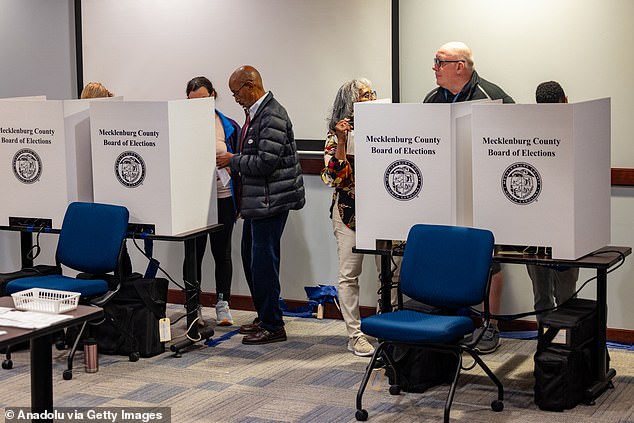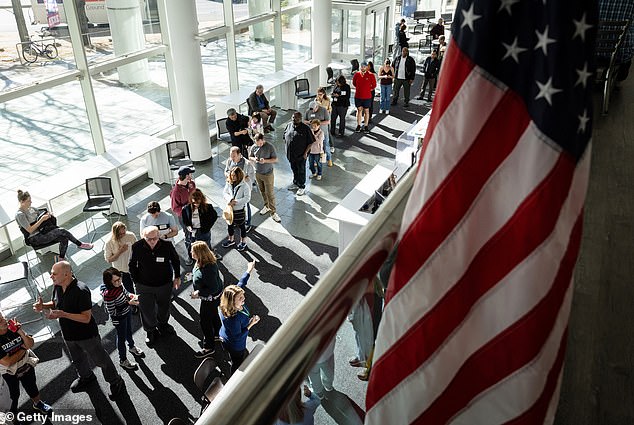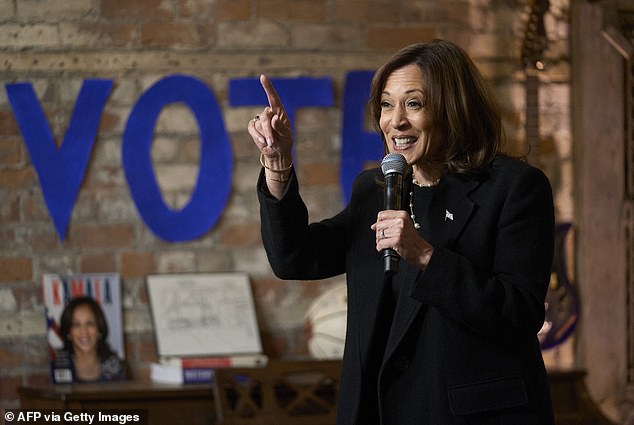Why the race isn’t as close as you think: With one week to go, analyst CRAIG KESHISHIAN predicts the polls are missing a hidden voter surge
In the final week of this dead heat presidential election, I am reminded of Ronald Reagan’s landslide victory in 1980.
Then, as now, President Jimmy Carter was neck and neck with his Republican challenger.
A Gallup poll showed Carter up one percentage point nationally at the end of October. Just four days before the election, a CBS News/New York Times poll showed the race was just as close.
Then the bottom fell out of Carter’s campaign—and Reagan won by nearly 10 points in the popular vote, and a whopping 489 to 49 in the Electoral College.
I was a young campaign analyst at the time, but later I joined Reagan’s vaunted political strategy team in the White House and we analyzed what caused the landslide.
In the final week of this dead heat presidential election, I am reminded of Ronald Reagan’s landslide victory in 1980.
We discovered thousands of previously overlooked Americans living in rural and suburban communities – people working 40 hours a week, hauling the freight, paying the bills and running the small businesses.
Their voices were not regularly heard in the halls of power and did not necessarily vote in every election.
They became known as ‘The Silent Majority’.
These men and women were not “country club” Republicans. Many were culturally conservative Democrats or independents fed up with rampant inflation, factory closings, failed foreign policies and rising crime.
That ‘Silent Majority’ changed the course of history.
Now, more than forty years later and just seven days after the 2024 elections, signs tell me that history may be repeating itself…
SUN BELT REPUBLICAN SURGE
Americans living in Nevada and Arizona have had a front-row seat to the fallout from massive illegal immigration under the Biden-Harris administration.
In both states, registered Republican voters cast more early ballots than registered Democrats — reversing a historic Democratic advantage.
Of course, these early ballots do not reveal actual vote counts, as they are not opened until Election Day. But these changing dynamics cannot be ignored.
As of Sunday, Republicans had a lead of 33,500 votes, or 5.2 percent of the total early votes.
Last week, Nevada Independent editor Jon Ralston described the result as “unheard of at this point in any other presidential cycle” and said there was “no good news” in the numbers for Democrats.

As of Sunday, Republicans had a lead of 33,500 votes, or 5.2 percent of the total early votes. (Above) Early voting in Las Vegas, Nevada on October 23, 2024
Things are even bleaker for Democrats in Arizona.
Republicans had returned nearly 42 percent of early ballots statewide as of Monday, compared to just over 35 percent of Democrats and 23 percent of independents.
This represents a swing of nearly 9 points in the Republican Party’s favor from the 2020 election.
The latest Trafalgar Poll released Monday provides yet another index by which to evaluate this race in Arizona: Trump leads Harris — 48 to 46 percent.
At this point in the 2016 race, Hillary Clinton had an average lead of 1.8 percent – and she ultimately lost by 1.5 points.
COLLECTING STORM VICTIMS
In North Carolina, meanwhile, Republicans are also outpacing Democrats in the return of early ballots.
After Hurricane Helene decimated the state’s heavily Republican western region last month, I worried that North Carolina could become a burden for Trump because his supporters might not be able to vote.
With people displaced, their homes destroyed and their lives turned upside down, you would assume that voting would be the last thing on their minds.
But the opposite has happened.
A record 2.8 million people in North Carolina have voted early, with tens of thousands of those votes coming from the storm-ravaged West.
As of last week, voters in the 25 counties in the FEMA-designated disaster area have submitted 0.5 percent more ballots than in 2020.

A record 2.8 million people in North Carolina (above) voted early, with tens of thousands of those votes coming from the storm-ravaged West.
What explains this kind of steadfastness?
While traveling across the state earlier this month, I was told by Victoria and William McKinley of weather-beaten Beech Mountain in Avery County that they would “crawl over broken glass to vote for Trump.”
That’s what we pollsters call “voter intensity,” a possible indication of a Silent Majority being stirred into action.
In nearby Georgia, which was also hit by Hurricane Helene, there was similarly robust early voting turnout.
Trump currently has slight leads in the polls in both Georgia and North Carolina
THE ‘KEY’ TRAPEZIAL STATE
However, one of the most difficult states to analyze may be the most critical in the election.
If Trump loses in Pennsylvania, his path to victory in the Electoral College will be significantly problematized.
Currently, early voters in the Keystone State favor Democrats, but not as much as they did four years ago.
In 2020, Democrats controlled nearly 70 percent of early votes at this point in the election, while registered Republicans made up just 20 percent of the total.
Today, registered Democrats cast nearly 60 percent of early votes and Republicans cast 30 percent.
It’s hardly a game changer, but it does represent a significant improvement.
And when these statistics are combined with polling and anecdotal evidence, it leads me to believe that support for Trump is increasing in the state.
Four years ago, Biden had a lead of almost four points and in 2016 Hillary Clinton led by five points – but Trump is currently just under 0.5 percent ahead.

However, one of the most difficult states to analyze may be the most critical in the election. If Trump loses in Pennsylvania, his path to victory in the Electoral College will be significantly problematized.
That is significant. And don’t take my word for it.
Late last week, Democratic Senator from Pennsylvania John Fetterman sounded the alarm about Trump’s “special bond” with the people of his state.
The “intensity” of support for Trump in his state is “astonishing,” he told the New York Times.
“It’s something that has taken on a life of its own,” he said. ‘That doesn’t mean I admire it. It’s just real.’
Meanwhile, the state’s veteran Democratic senator, Bob Casey, who is running for re-election in a competitive race, is airing campaign ads touting his working relationship with Trump.
When two veteran lawmakers say their opponent is showing strength, it pays to pay attention.
DEMOCRATIC ALLIES WANT
Finally, there are two intriguing developments from Democratic strongholds in different parts of the province.
First, in Michigan – another crucial prize in this election. Trump won it in 2016 by a mustache. Biden reclaimed it in 2020.
Again, early voting has increased, but the state does not release information about the party affiliation of those casting early ballots.
However, this is reason to suspect that the enthusiasm of the state’s Democratic voters has been somewhat dampened.
In a new survey by veteran pollster John Zogby and the Arab American Institute, Trump jumps out to a 46 percent to 42 percent lead over Harris among the state’s likely Arab American voters.
That’s a big deal, considering Michigan is home to the largest concentration of Arab-Americans in the U.S., with an estimated population of more than 200,000 residents statewide.
This voting bloc — normally considered a safe bet for Democrats — now appears to be softly responding to Harris, deterred by the current administration’s continued support for Israel.
Meanwhile, polls also show that black and Hispanic voters favor Trump by historic margins. Harris knows this, hence her increased efforts in recent weeks to sway black male voters with promises of handouts.

This voting bloc — normally considered a safe bet for Democrats — now appears to be softly responding to Harris, deterred by the current administration’s continued support for Israel.
I’m also looking at Miami-Dade County, in southeast Florida, a traditional Democratic stronghold, but registered Republicans in the county currently have a lead of nearly 30,000 votes.
What is happening here and across the country? Why are previously reliable groups eluding Democrats? Why is Harris losing traditional advantages?
I believe there is a shift happening that the polls have not yet picked up on.
Even as a polling analyst, I have to admit that the predictive power of polls in America is limited. Opinion polls can be flawed by chance, incompetence or even deception.
There is another “measure” that I have found useful – and it is based on forty years of experience measuring the attitudes of the American people and getting a sense of what they really think.
And it’s starting to ‘feel’ like 1980 all over again.
